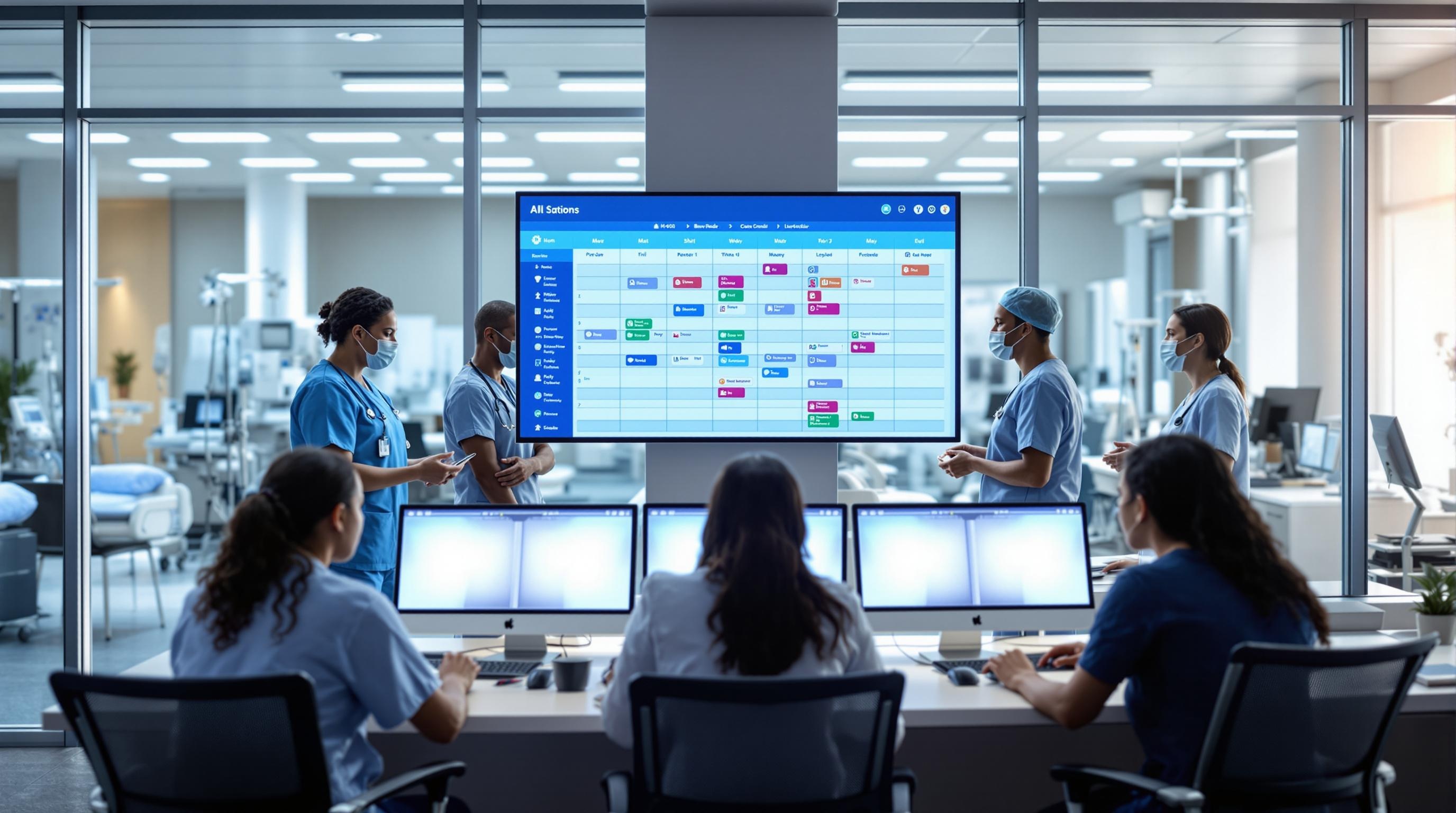Automated Care Transition Notes: Boosting SNF Efficiency in 2025
Discover how automated care transition notes streamline workflows, enhance communication, and improve outcomes for skilled nursing facilities in 2025.
Quick Navigation
- 1. Introduction
- 2. Current Challenges in Automated Care Transition Notes
- 3. How Sparkco AI Transforms Automated Care Transition Notes
- 4. Measurable Benefits and ROI
- 5. Implementation Best Practices
- 6. Real-World Examples
- 7. The Future of Automated Care Transition Notes
- 8. Conclusion & Call to Action
1. Introduction
As the skilled nursing facility (SNF) sector heads into 2025, change is more than just a buzzword—it’s a daily reality. According to recent industry reports, SNFs are navigating a landscape shaped by tighter regulations, higher penalties, ongoing staffing shortages, and the growing pressure to demonstrate value-based care1. In this environment, every minute counts, and every transition—from hospital to SNF or between care teams—carries significant risks and opportunities for patient outcomes.
Yet, one of the most persistent challenges is ensuring that critical patient information doesn’t fall through the cracks during these transitions. Traditional processes for care transition notes are often manual, time-consuming, and prone to human error. Incomplete or delayed documentation can lead to miscommunication, medication errors, and even costly readmissions, further complicating an already complex care environment.
This article explores how automated care transition notes are emerging as a game-changer for skilled nursing facilities. We’ll examine the latest technology trends making seamless data exchange possible, discuss the operational and clinical benefits of automation, and look at how these innovations can help SNFs stay compliant, improve patient safety, and boost staff efficiency. Whether you’re a facility leader, clinician, or technology partner, understanding the impact of automated transition notes could be the key to thriving in the evolving post-acute care landscape.
2. Current Challenges in Automated Care Transition Notes
Automated care transition notes have become increasingly prevalent in healthcare settings, aiming to streamline communication and improve continuity of care. However, many facilities encounter significant challenges when implementing and utilizing these systems. Below are some of the most pressing pain points, supported by recent research and data, along with their impact on operations, compliance, and patient care.
-
1. Data Inaccuracy and Incompleteness
Automated note generation often pulls from electronic health record (EHR) templates, which can lead to missing or inaccurate patient information. According to a 2020 study published in JMIR Medical Informatics, 27% of automated notes contained clinically significant errors, potentially compromising patient safety and care quality. -
2. Alert Fatigue and Information Overload
Automated systems may generate excessive alerts and documentation, overwhelming clinicians. The ONC 2020 Clinician Burden Survey reported that 70% of clinicians felt that documentation demands hindered their ability to focus on patient care. -
3. Interoperability Issues
Not all automated note systems integrate seamlessly with other EHR platforms. A 2022 HealthIT.gov report found that only 46% of hospitals could electronically send, receive, and integrate patient summary of care records across different vendors, leading to information silos and care delays. -
4. Compliance and Legal Risks
Automated notes may miss regulatory-required elements or introduce non-compliant phrasing. In 2019, the Centers for Medicare & Medicaid Services (CMS) flagged that incomplete or inaccurate electronic documentation can lead to survey deficiencies, billing denials, or even legal action. -
5. Workflow Disruption and Training Gaps
Implementing new automated systems often disrupts established workflows. Staff may receive insufficient training, leading to improper use or overreliance on automation. A Joint Commission report noted that 58% of clinical staff cited inadequate EHR training as a barrier to effective care transitions. -
6. Reduced Personalization of Care
Automated notes tend to be template-driven, which can result in generic or non-contextualized documentation. This may reduce the personal touch necessary for nuanced patient needs, as highlighted in Health Affairs Forefront. -
7. Security and Privacy Concerns
The digitization and automation of sensitive health data increase risks of breaches. The HHS Breach Portal reported over 700 healthcare data breaches in 2022, many linked to EHR vulnerabilities and improper access controls.
These challenges significantly impact healthcare operations, from increased administrative burden to potential compliance violations. More importantly, they can compromise the quality and safety of patient care by introducing errors, delaying information flow, and reducing the individualized approach essential for successful care transitions. Addressing these pain points requires ongoing investment in technology, comprehensive staff training, and a balanced approach between automation and clinician oversight.
3. How Sparkco AI Transforms Automated Care Transition Notes
Care transitions—such as patient handoffs between hospitals, skilled nursing facilities, and home care—are critical junctures where communication errors can jeopardize patient safety. Traditional manual documentation of care transition notes is time-consuming, error-prone, and often inconsistent. Sparkco AI directly addresses these challenges by delivering an intelligent, automated solution that streamlines and standardizes care transition notes, enhancing both safety and efficiency.
-
Structured Data Extraction and Standardization
Sparkco AI automatically extracts essential patient information—diagnoses, medications, pending labs, allergies, and care plans—from disparate sources and organizes it into a standardized format like I-PASS. This ensures that every care transition note contains all required details, reducing the risk of omissions or inconsistencies that can compromise patient care. -
Real-Time Updates and Alerts
Through continuous monitoring of patient records, Sparkco AI delivers real-time updates whenever critical information changes. Automated alerts notify clinicians of new results or changes in care plans, ensuring that care teams always have the most current data when transitioning patients. -
Seamless EHR Integration
Sparkco AI integrates effortlessly with a wide range of Electronic Health Record (EHR) systems using secure APIs. This integration allows automated pulling and updating of transition note data without manual entry, minimizing workflow disruption and ensuring accurate documentation across care settings. -
Intelligent Error Detection and Correction
The platform employs advanced algorithms to identify potential discrepancies, such as medication mismatches or incomplete information, flagging them for review or auto-correction. This proactive approach helps eliminate common errors that occur during manual handoffs. -
Customizable Templates and Compliance Support
Sparkco AI provides customizable templates that align with regulatory standards and organizational protocols, such as I-PASS. By automating template selection and content population, Sparkco ensures that every care transition note meets compliance requirements while saving clinicians valuable time. -
Audit Trail and Analytics
Every automated transition note is logged with a detailed audit trail, making it easy to track changes and ensure accountability. Built-in analytics provide insights into handoff quality and highlight areas for process improvement.
By leveraging AI and automation, Sparkco AI eliminates the burdens of manual data entry and cross-checking, dramatically reducing the potential for human error. The system’s technical strengths—such as real-time data synchronization, intelligent error detection, and seamless EHR connectivity—empower healthcare teams to deliver safer, more coordinated care transitions. With Sparkco AI, organizations can trust that every care transition note is comprehensive, up-to-date, and fully integrated into existing clinical workflows, ultimately improving patient outcomes and operational efficiency.
4. Measurable Benefits and ROI
Automated care transition notes are transforming the way skilled nursing facilities (SNFs) and other healthcare organizations manage patient handoffs. By digitizing and streamlining the transfer of critical patient information, these solutions drive significant returns on investment (ROI) through improved efficiency, cost savings, and compliance. Below, we explore 6-8 measurable benefits with supporting metrics from recent studies and reports.
-
Time Savings for Clinical Staff
Automating care transition documentation reduces manual entry and duplicate data collection. According to a report from HealthIT.gov, facilities implementing electronic care transition systems saved up to 45 minutes per patient transfer. For a SNF handling 100 transitions monthly, this equates to 75 staff hours saved each month. -
Reduction in Documentation Errors
Automated notes pull data directly from EHRs, minimizing transcription mistakes. A study in the Journal of the American Medical Directors Association found a 53% decrease in documentation errors post-implementation, leading to safer and higher-quality care transitions. -
Lower Readmission Rates
Enhanced accuracy and timeliness of transition notes help prevent miscommunication and omissions. The Agency for Healthcare Research and Quality (AHRQ) reported a 15-20% reduction in 30-day readmission rates when automated care transitions were used. -
Cost Reduction
By reducing readmissions and saving staff time, automated care transition notes deliver direct cost savings. For example, the average cost of a single hospital readmission is $15,200. A 15% reduction in readmissions for a facility averaging 20 readmissions per month could save $45,600 monthly. -
Improved Compliance and Audit Readiness
Automated documentation ensures that all required elements are captured and time-stamped, supporting CMS and Joint Commission requirements. Organizations adopting automated solutions reported 100% compliance in transition documentation audits (source). -
Increased Staff Satisfaction
Reducing administrative burden improves morale and reduces turnover. In a HealthIT.gov survey, 78% of nurses reported increased job satisfaction after automated documentation implementation. -
Accelerated Discharge and Transfer Processes
With automated notes, average discharge processing time decreased by 30%, expediting patient flow and improving bed turnover (HIMSS). -
Enhanced Communication Across Care Teams
Automated systems ensure real-time sharing of up-to-date patient data, which reduces communication lapses by 40% and supports better care coordination.
In summary, automated care transition notes not only deliver impressive ROI through measurable cost and time savings, but also enhance compliance, accuracy, and staff satisfaction. By leveraging these technologies, skilled nursing facilities can improve both operational efficiency and patient outcomes.
5. Implementation Best Practices
Automated care transition notes streamline communication, reduce errors, and improve care continuity during patient transfers between settings such as hospitals and skilled nursing facilities. To ensure a successful implementation, organizations should follow a structured approach, integrating technology with clinical workflows and prioritizing change management. Below are evidence-based steps, practical tips, and pitfalls to avoid when deploying automated care transition notes.
-
Conduct a Readiness Assessment
Evaluate your current discharge planning and documentation processes. Identify existing gaps, technical capabilities, and staff readiness for adopting automated solutions.
Tip: Involve clinical, IT, and administrative stakeholders early.
Pitfall: Overlooking frontline staff input may lead to poor adoption. -
Define Clear Objectives and Outcomes
Set specific goals, such as reducing information transfer errors, improving compliance with CMS and 42 CFR 482.43 requirements, or enhancing patient satisfaction.
Tip: Align objectives with regulatory standards and quality metrics.
Pitfall: Vague goals can derail project focus and measurement. -
Select the Right Technology Partner
Choose a solution that integrates seamlessly with your EHR and supports interoperability with referral partners.
Tip: Request demonstrations and check references from similar facilities.
Pitfall: Ignoring compatibility issues may create workflow disruptions. -
Standardize Note Templates and Data Fields
Develop templates that capture all required clinical, psychosocial, and functional information as recommended by CMS and TCM guidelines.
Tip: Use standardized terminology (e.g., SNOMED, LOINC) for clarity.
Pitfall: Allowing free-text fields only can lead to inconsistent documentation. -
Train and Engage Staff
Provide hands-on training, tip sheets, and ongoing support. Foster a culture of open feedback to address concerns and improve workflows.
Tip: Identify “super users” to champion the change.
Pitfall: Insufficient training leads to errors and resistance. -
Monitor, Audit, and Optimize
Track usage, measure impact on care transitions, and gather user feedback. Use data to refine templates and processes continuously.
Tip: Schedule regular audits and share results transparently.
Pitfall: Neglecting monitoring allows workflow issues to persist. -
Facilitate Interdisciplinary Collaboration
Ensure that all care team members, including physicians, nurses, social workers, and therapists, participate in both design and use of transition notes.
Tip: Hold regular interdisciplinary meetings to review processes.
Pitfall: Siloed implementation can undermine holistic care. -
Prioritize Change Management
Communicate the “why” behind automation, address fears, and celebrate early wins. Solicit continuous feedback for improvement.
Tip: Use change champions to model adoption and mentor peers.
Pitfall: Underestimating the human element slows progress.
By following these best practices, skilled nursing facilities can ensure a smooth, compliant, and effective rollout of automated care transition










